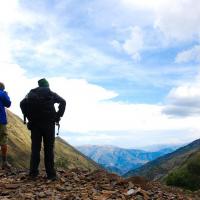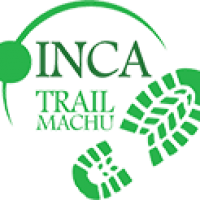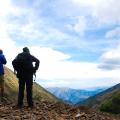On the route to Macchu Pichu, rivers and steep hills are some of the challenges for tourists.
Facing a path is the most intense experience anyone can have in the Andes. The most famous of these, the Inca, takes you to the city of Machu Picchu, located in the transition from the mountains to the Amazon. But the menu offered by tourism agencies in Cusco, the Peruvian capital of tourism par excellence, goes far beyond this, one of the most coveted trekkings in the world. There are a reasonable number of different routes to be considered by those who enjoy walking and know how to appreciate the delicate brutality of the Andean nature.
The Qhapaq Ñan, 'The Royal Way' in Quechua, is defended by many historians as the greatest legacy left by the people who dominated the Andes and the Pacific coast in South America before the arrival of the Spaniards. This network of intertwined roads connected the territories of Tahuantinsuyo, the original name of the Inca Empire, which means "the four regions." Scholars estimate that the Incas have paved about 40 thousand kilometers of roads to connect places now occupied by Colombia, Ecuador, Peru, Bolivia, Chile and Argentina.
In those days, all this constituted a single nation, and the most effective way to control this vast territory was to have access to its most remote corners. This was the main reason why the Incas dedicated themselves to building and taking care of their roads. In addition to allowing austere state control, these routes facilitated trade flow between the different regions, a condition without which the Inca Empire could never have been consolidated.
Today, the recovery of Qhapaq Ñan has been seen as an engine of tourism development for the countries it interconnects. To monitor this potential, the governments of the aforementioned nations signed a multilateral cooperation agreement to rescue as many kilometers as possible and, beginning with integration with local communities, begin their commercial exploration, with an obvious focus on tourism.
There is much to come in the coming years. Even so, for the moment, some routes that belong to the extensive Inca network are already available for travelers. To discover them, simply put your backpack on your back, hire the relevant camping and food services, as well as a good guide, and go on the road.
Despite its greatness, the only world-famous stretch of Qhapaq Ñan is the road that ends at Machu Picchu, better known as the Classic Inca Trail. July is the most recommended month to face it, but it is also the most popular. This is the dry season, without rain, which ends up making the walkers' task much easier. Despite this, it is cold at night and the very low relative humidity of the air must also be taken into account. You cannot neglect hydration.
Experienced guides also recommend September and October for the Inca Trail. They are equally dry months and, for the moment, less disputed by the gringos. This time it also favors the observation of the Milky Way in the cold Andean sunrises, especially in the Chinchero region, populated about 35 kilometers from Cusco and almost 3,800 meters above sea level.
First, however, to succeed in the effort, the slogan is planning. The waiting list to join the Inca Trail exceeds one year. It is not the same as before, when it was enough to get to Cusco and book the tour. Now, everything is controlled. The address of the Archaeological Park of Machupicchu stipulates in 500 the number of hikers who can access the route at the same time, including tourists, guides, porters and cooks.
By the way, like the Inca Trail, the entrance to Machu Picchu, restricted to 2,500 people per day, must also be booked in advance via the Internet (
www.machupicchu.gob.pe), as well as the ascent to Huayna Picchu, The mountain that frames the stone citadel. So don't think about leaving home without programming. And be careful with who indiscriminately offers the itinerary through the Plaza de Armas of Cusco. The Peruvian government classifies these people as "unscrupulous"; besides not being able to do it, they can put the unsuspecting in a tremendous robbery.
Choquequirao and Vilcabamba, even more challenges
Last bastion of the Inca resistance to the Spanish invasion, Vilcabamba is part of one of the most challenging walks in the Andes. Bordered by the deep canyons of Apurimac and Willcamayu, the city welcomed the remaining royal Inca lineage that resisted the Iberians for years in the mid-16th century.
Choquequirao, or cradle of gold in Quechua, is located in an impressive ravine also protected by the Apurimac River. It is a classic Inca city, with sacred, urban and agricultural sectors. Only 30% of its total area is excavated, but an association between the governments of Peru and France promises to accelerate the work and, bet, convert it into a new Machu Picchu.
Getting to know Vilcabamba and Choquequirao Trek closely requires time and even more spirit of adventure than, for example, walking along the Salcantay Trail or even the Inca Trail. It is possible to do it in parts or in a single take (teacher, for example) in an itinerary of 13 to 15 days that also includes Machu Picchu.
Less time, but well spent
If the idea is to make contact with isolated villages that preserve their ancestral lifestyle, do not think twice before choosing to go hiking in Vale de Lares. In it, travelers tour the Inca archeological sites and visit agricultural villages, indigenous communities and families of weavers during the four days of a trip that brings them closer to the clouds, at 4,400 meters above sea level.
Even those who have less time can also experience the experience of crossing Inca roads in the Sacred Valley tours region, on the outskirts of Cusco. The route that leads to the archeological site of Huchuy Qosqo has the correct measure: the travelers walk from six to eight hours to reach the ruins of the palace where the sovereign Viracocha took refuge when the Chancas, archrivals of the Incas, attacked Cusco around 1440 It depends on Cusi Yupanqui, one of Viracocha's children, to contain the momentum of the invaders. After defeating their most feared enemies, the Incas were finally able to begin the peak of their expansion.
Cusi Yupanqui assumed power, changed its name to Pachacutec, the transformer of the world, undertook several successful campaigns and created, in fact, a state model that would be known as the Inca Empire. Considered the largest among his peers, Pachacutec also ordered the construction of Machu Picchu, perhaps the greatest architectural feat of his government and the final destination of the best trekking in the Andes








